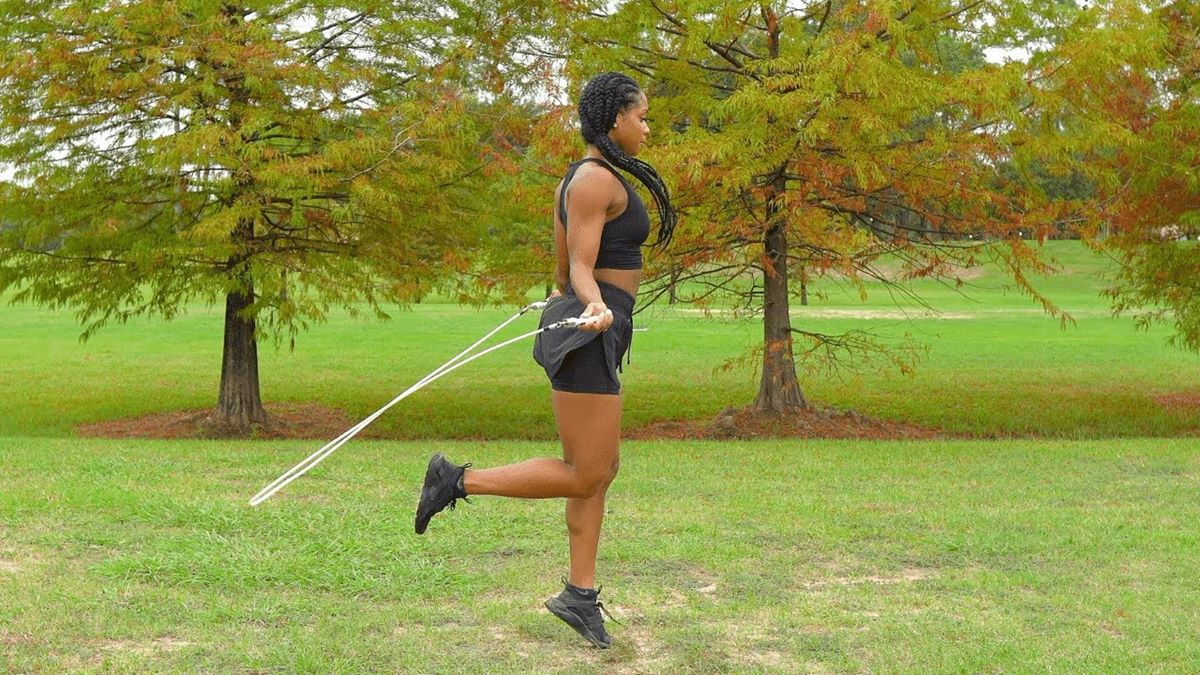

Featured
How To Jump Rope For Stamina
Modified: January 2, 2024
Learn how to jump rope for stamina and boost your fitness level with our featured guide. Follow these expert tips and work your way towards a stronger and more enduring body.
Introduction
Jumping rope is not just child’s play; it’s a highly effective and efficient exercise that can significantly improve your stamina. Whether you’re a beginner looking to build your endurance or an athlete aiming to boost your performance, incorporating jump rope workouts into your fitness routine can yield impressive results.
Jumping rope involves continuous, rhythmic motions that engage your entire body and elevate your heart rate. It’s a great cardiovascular exercise, similar to running or cycling, but with the added benefit of being portable and inexpensive. All you need is a good quality jump rope and enough space to move freely.
One of the main advantages of jumping rope for stamina is its ability to improve your aerobic capacity. Regular jump rope workouts can enhance your lung capacity, increase oxygen delivery to your muscles, and improve your overall cardiovascular fitness. This can lead to better endurance and stamina, allowing you to perform better in various physical activities and sports.
Jumping rope can also help to strengthen your leg muscles, including your calves, quadriceps, and hamstrings. The repetitive jumping motion engages these muscles, building strength and endurance over time. Additionally, the rotational motion of your arms while turning the rope helps to tone your shoulders, arms, and core muscles.
Another advantage of jumping rope for stamina is its versatility. You can customize your jump rope workouts to match your fitness level and goals. Whether you’re a beginner who wants to start slow or an experienced athlete looking for a high-intensity workout, there are various techniques and routines you can incorporate into your training.
In this article, we will explore the benefits of jumping rope for stamina and how to properly incorporate it into your fitness routine. We will also provide tips to improve your stamina while jumping rope, safety precautions to keep in mind, and common mistakes to avoid. So grab your jump rope and get ready to elevate your endurance to new heights!
Benefits of Jumping Rope for Stamina
Jumping rope is a fantastic exercise for improving stamina and endurance. Let’s explore some of the key benefits:
1. Cardiovascular Fitness: Jumping rope gets your heart pumping and increases your heart rate, making it an excellent cardiovascular exercise. This helps to improve your aerobic capacity and overall cardiovascular fitness, leading to better stamina and endurance.
2. Full Body Workout: Jumping rope engages multiple muscle groups simultaneously, including your legs, arms, shoulders, and core. This means that not only are you working on your stamina, but you’re also building strength and toning your muscles as well.
3. Portable and Convenient: One of the advantages of jumping rope is that it can be done almost anywhere. All you need is a jump rope and enough space to swing it. Whether you’re at home, in a park, or traveling, you can easily fit in a jump rope workout to improve your stamina.
4. Efficient Calorie Burner: Jumping rope is a high-intensity exercise that can burn a significant number of calories in a short amount of time. This makes it an effective option for weight loss and maintaining a healthy body composition, while also improving your stamina.
5. Improves Coordination and Balance: Jumping rope requires coordination and timing between your feet and arms. Regular practice can enhance your proprioception and balance, making you more agile and coordinated in other activities and sports.
6. Mental Focus and Stress Relief: Jumping rope requires concentration and coordination, which can help improve your mental focus and cognitive abilities. It can also serve as a form of stress relief, helping to release endorphins and promote a sense of well-being.
7. Customizable Workouts: Whether you’re a beginner or a seasoned athlete, jumping rope workouts can be tailored to your fitness level and goals. You can adjust the intensity, duration, and incorporate different techniques and variations to challenge yourself and improve your stamina gradually.
8. Fun and Versatile: Jumping rope can be a fun and enjoyable exercise. It offers a wide range of variations, such as single jumps, double unders, criss-crosses, and more. This variety keeps the workouts interesting and allows you to continuously challenge yourself.
Incorporating jumping rope into your fitness routine can bring a myriad of benefits for your stamina and overall fitness. From improving cardiovascular health and endurance to building strength and coordination, jumping rope is a versatile exercise that provides an efficient and effective workout.
Choosing the Right Jump Rope
When it comes to jumping rope for stamina, selecting the right jump rope is key. Here are some factors to consider when choosing the perfect jump rope for your needs:
1. Length: The length of the jump rope is crucial for proper technique and performance. Stand on the middle of the rope and make sure the handles reach your armpits. This allows for enough clearance as you swing the rope over your head and under your feet.
2. Material: Jump ropes can be made from various materials, such as PVC, nylon, or steel cables. PVC ropes are lightweight and suitable for beginners, while nylon ropes offer durability. Steel cables are more advanced and provide a faster rotation speed, making them ideal for experienced jump rope enthusiasts.
3. Weight: Consider the weight of the jump rope. Lighter ropes are easier to handle and perfect for speed and quick movements. Heavier ropes provide more resistance, helping to build strength and endurance. Choose a weight that suits your fitness level and goals.
4. Handles: The handles of the jump rope should be comfortable to grip and provide a secure hold. Look for handles with a non-slip or padded grip to prevent slipping and improve control during your workouts. Ergonomic handles are also beneficial for reducing hand fatigue.
5. Adjustable: An adjustable jump rope allows you to customize the length to fit your height and preference. This is particularly useful if multiple people will be using the same rope or if you want to experiment with different jump rope techniques.
6. Consider your Fitness Level: Beginners may want to start with a basic jump rope, while more experienced jumpers might opt for a speed rope or a weighted rope. Take your current fitness level into account when choosing the jump rope that best suits your needs.
7. Budget: Consider your budget when purchasing a jump rope. While there are expensive options with advanced features, there are also affordable options that offer great quality. Look for a jump rope that provides a balance between durability, functionality, and price.
Remember, the right jump rope for you will ultimately depend on your personal preferences, fitness level, and goals. Experiment with different types of jump ropes to find the one that feels comfortable and suits your needs best. It’s also worth considering seeking advice from fitness professionals or experienced jump rope enthusiasts.
With the right jump rope in hand, you’ll be ready to embark on your journey to improve your stamina through jumping rope workouts.
Proper Jump Rope Technique
Mastering the proper jump rope technique is essential for maximizing the benefits of your workouts and ensuring safety. Follow these steps to ensure you have the correct form:
1. Start with Proper Posture: Stand tall with your shoulders relaxed and your core engaged. Keep your head facing forward and your gaze straight ahead, rather than looking down at your feet.
2. Grip the Handles: Hold the handles of the jump rope with a firm but relaxed grip. Make sure your wrists are aligned with your arms, and your elbows are slightly bent. Avoid tension in your hands and forearms, as this can lead to fatigue and discomfort.
3. Find the Right Jumping Rhythm: Begin by swinging the rope overhead using your wrists and forearms. As the rope comes around, jump off the balls of your feet, keeping your knees slightly bent. Jump just high enough to clear the rope, aiming for light and controlled movements.
4. Maintain a Consistent Rope Swing: The key to a smooth and consistent jump rope motion is controlling the rope swing. Use your wrists and forearms to generate the rotation, keeping your elbows close to your sides. Avoid using excessive arm movements or shoulder rotations, as this can disrupt your rhythm.
5. Land Lightly: As you land, focus on landing softly and quietly on the balls of your feet. Avoid landing with a heavy impact, as this can cause unnecessary stress on your joints. Engage your calf muscles and absorb the impact to minimize strain on your knees and ankles.
6. Maintain an Even Tempo: Aim for a steady and consistent tempo throughout your jump rope workout. This will help you maintain a good rhythm and sustain your stamina. Start with a manageable pace, gradually increasing the speed as you improve your endurance.
7. Breathe Properly: Remember to breathe deeply and exhale fully while jumping rope. Coordinate your breathing with your jumping rhythm to ensure a steady flow of oxygen to your muscles. This will help you maintain your stamina and prevent fatigue.
8. Practice Patience and Persistence: Like any exercise, mastering the proper jump rope technique takes time. Start with shorter sessions and gradually increase the duration as you become more comfortable and confident. Consistent practice will refine your technique and improve your stamina over time.
By following these guidelines and paying attention to your form, you can optimize your jump rope workouts and achieve the best results. Remember to listen to your body and modify the intensity and duration of your workouts as needed. Proper technique combined with regular practice will help you enhance your stamina and reap the benefits of jump rope training.
Warm-up Exercises
Before diving into a jump rope workout for stamina, it’s important to properly warm up your body to prevent injury and prepare your muscles for exercise. Here are some effective warm-up exercises to incorporate into your routine:
1. Jumping Jacks: Start with a classic exercise like jumping jacks. Stand with your feet together and arms by your sides. Jump your feet wide while simultaneously raising your arms above your head. Return to the starting position and repeat for a set duration to elevate your heart rate and warm up your entire body.
2. Arm Circles: Stand with your feet shoulder-width apart and extend your arms straight out to the sides. Begin making small circles with your arms, gradually increasing the size of the circles. After a set number of repetitions, reverse the direction of the circles. This exercise helps to warm up your shoulder joints and improve flexibility.
3. High Knees: Stand tall with your feet hip-width apart. Lift one knee towards your chest, while keeping your core engaged and back straight. Alternate legs in a jogging motion, bringing your knees as high as possible. This exercise engages your hip flexors, activates your lower body muscles, and raises your heart rate.
4. Toe Touches: Stand with your feet shoulder-width apart and extend your arms above your head. Bend forward at the waist, reaching your hands towards your toes. Engage your core and reach as far as you can comfortably. Rise back up to the starting position and repeat for a set number of repetitions. This exercise helps to stretch your hamstrings and lower back.
5. Lunges: Stand with your feet hip-width apart and take a step forward with your right foot. Lower your body into a lunge position, with your right knee bent at a 90-degree angle and your left knee hovering just above the floor. Push off with your right foot to return to the starting position and repeat on the opposite side. Lunges warm up your leg muscles and improve your balance and stability.
6. Arm Swings: Stand with your feet shoulder-width apart and extend your arms straight out in front of you. Begin swinging your arms back and forth in a controlled motion, increasing the range of motion gradually. After a set number of repetitions, switch to swinging your arms side to side. This exercise helps to loosen up your shoulder joints and warm up your upper body.
7. Ankle Circles: Sit on the edge of a chair or a mat, with one leg extended straight in front of you. Rotate your ankle clockwise in a circular motion, making sure to keep the movement controlled and gentle. After a set number of repetitions, switch to counterclockwise rotations. This exercise helps to warm up your ankles and improve flexibility.
8. Dynamic Stretching: Perform dynamic stretches that mimic the movements you’ll be doing during your jump rope workout. This can include leg swings, torso rotations, or arm swings. Dynamic stretching helps to increase blood flow, improve joint range of motion, and activate the muscles you’ll be using.
Remember to perform each warm-up exercise for a sufficient amount of time to properly prepare your body for the jump rope workout. The duration and intensity of your warm-up will depend on your fitness level and personal preference. Incorporating these warm-up exercises into your routine will help prevent injury, enhance your performance, and improve your stamina during your jump rope workouts.
Beginner Jump Rope Workout for Stamina
If you’re new to jumping rope, it’s important to start with a beginner-friendly workout to gradually build your stamina. Here’s a beginner jump rope workout that will help improve your endurance:
1. Warm-up: Begin with a 5-10 minute warm-up session, including exercises like jumping jacks, arm circles, high knees, and dynamic stretching to prepare your muscles and elevate your heart rate.
2. Basic Jump (30 seconds): Start by jumping rope with a basic two-foot jump. Keep your feet together and maintain a steady pace. Jump for 30 seconds, focusing on maintaining rhythm and proper form.
3. Rest (30 seconds): Take a 30-second rest to catch your breath and prepare for the next exercise.
4. Single Leg Jump (15 seconds each leg): Jump rope on one leg, lifting the opposite leg slightly off the ground. Alternate legs after 15 seconds. This exercise helps to improve balance, coordination, and leg strength.
5. Rest (30 seconds): Take a short rest before moving on to the next exercise.
6. Speed Skips (30 seconds): Perform speed skips by jumping slightly higher and rotating the rope faster. Increase your jumping speed while maintaining control and good form. This exercise helps to increase your heart rate and improve coordination.
7. Rest (30 seconds): Take another short rest before proceeding to the next exercise.
8. Alternating Foot Step (30 seconds): Alternate between hopping on one foot and quickly switching to the other foot while jumping rope. Keep the movement light and controlled. This exercise helps to improve agility and footwork.
9. Rest (30 seconds): Take a brief rest before the final exercise.
10. Double Unders (15 seconds): Attempt to perform double unders, where the rope passes twice under your feet with each jump. If you’re not able to do double unders yet, continue with basic jumps. This exercise challenges your coordination and timing.
11. Cool Down: Finish your workout with a 5-10 minute cool down, including light stretching to ease any tension in your muscles and promote recovery.
Remember to listen to your body and adjust the intensity and duration of the exercises based on your fitness level. As a beginner, it’s important to gradually increase the duration and intensity of your jump rope workouts to avoid overexertion or injury. Consistency and regular practice will help improve your stamina and allow you to progress to more challenging workouts in the future.
Intermediate Jump Rope Workout for Stamina
If you’ve already built a solid foundation with your jump rope skills, it’s time to take your stamina to the next level with an intermediate-level workout. This workout incorporates more intense exercises to challenge your endurance. Here’s an intermediate jump rope workout for improving your stamina:
1. Warm-up: Begin with a 5-10 minute warm-up session, including exercises like jumping jacks, arm circles, high knees, and dynamic stretching to prepare your muscles and elevate your heart rate.
2. Basic Jump (60 seconds): Start with a 60-second session of basic two-foot jumps. Focus on maintaining a consistent rhythm and form. Gradually increase your speed as you become more comfortable.
3. Rest (30 seconds): Take a 30-second rest to catch your breath and prepare for the next exercise.
4. Double Unders (30 seconds): Challenge yourself with 30 seconds of double unders, where the rope passes under your feet twice with each jump. If you’re still working on perfecting double unders, continue with basic jumps or single unders. Focus on maintaining a fast and consistent rotation of the rope.
5. Rest (30 seconds): Take a short rest before the next exercise.
6. High Knee Jump (60 seconds): Jump rope while lifting your knees as high as possible, aiming to bring them level with your hips. Engage your core and focus on the explosive movement. This exercise increases your heart rate and works your leg muscles.
7. Rest (30 seconds): Take another brief rest before moving on to the next exercise.
8. Boxer Shuffle (60 seconds): Perform the boxer shuffle by hopping from side to side while moving your arms in a boxing-like motion. Maintain a rapid pace and stay light on your feet. This exercise improves agility, coordination, and cardiovascular endurance.
9. Rest (30 seconds): Take a short rest before the next exercise.
10. Criss-Cross (60 seconds): Challenge yourself with criss-cross jumps, where you cross your arms in front of you on each jump. Focus on a quick hand movement and timing the arm cross smoothly. This exercise adds complexity and intensifies the workout.
11. Rest (30 seconds): Take a brief rest before the final exercise.
12. Sprint Intervals (60 seconds): Finish the workout with 60 seconds of high-intensity sprint intervals. Alternate between 30 seconds of fast-paced jumping and 30 seconds of rest. Push yourself to jump as fast as you can during the sprint intervals, maximizing your effort and challenging your stamina.
13. Cool Down: Finish your workout with a 5-10 minute cool down, including light stretching to ease any tension in your muscles and promote recovery.
Keep in mind that as an intermediate jumper, it’s important to monitor your form and technique to prevent injury. Gradually increase the duration and intensity of your jump rope workouts over time. With consistency and dedication, this intermediate workout will help you improve your stamina and continue progressing toward advanced jump rope skills.
Advanced Jump Rope Workout for Stamina
If you’re an experienced jumper looking to push your stamina to the limits, an advanced jump rope workout will challenge your endurance and elevate your fitness level. This workout incorporates intense exercises and longer durations to test your stamina. Here’s an advanced jump rope workout to take your endurance to new heights:
1. Warm-up: Begin with a 5-10 minute warm-up session, including exercises like jumping jacks, arm circles, high knees, and dynamic stretching to prepare your muscles and elevate your heart rate.
2. Double Under Intervals (60 seconds): Start with 60 seconds of double unders, where the rope passes twice under your feet with each jump. Maintain a fast pace and focus on smooth rotations. If double unders are too challenging, switch to single unders but increase your jumping speed.
3. Rest (30 seconds): Take a 30-second rest to catch your breath and prepare for the next exercise.
4. Triple Under Attempts (30 seconds): Challenge yourself with attempts at triple unders, where the rope passes under your feet three times with each jump. This exercise requires excellent timing, coordination, and control. If triple unders are not yet achievable, continue with double unders or single unders.
5. Rest (30 seconds): Take a short rest before the next exercise.
6. High Knees Sprint (60 seconds): Perform high knees while jumping rope, emphasizing speed and explosive movements. Lift your knees as high as possible, engaging your core and maintaining a fast pace. This exercise targets your leg muscles and elevates your heart rate.
7. Rest (30 seconds): Take another brief rest before moving on to the next exercise.
8. Tabata Style Intervals (4 minutes): Perform Tabata intervals, which consist of 20 seconds of all-out effort followed by 10 seconds of rest. Alternate between 20 seconds of fast-paced jumping and 10 seconds of rest for a total of 4 minutes. Push yourself to jump at your maximum speed during the intervals.
9. Rest (30 seconds): Take a short rest before the next exercise.
10. Cross-Step Jump (60 seconds): Add complexity to your jumps by incorporating a cross-step. Jump rope as you would for basic jumps, but on each jump, cross your right foot in front of your left foot, then uncross as you land. Alternate the cross-step with each jump. This exercise challenges your coordination and rhythm.
11. Rest (30 seconds): Take another brief rest before the final exercise.
12. Pyramid Workout: Perform a pyramid workout by starting with 10 jumps, then increasing the number of jumps by 10 with each set (i.e., 10, 20, 30, and so on). Take a short rest between each set. Reach as high as you can within your capabilities, focusing on maintaining your form and intensity throughout the workout.
13. Cool Down: Finish your workout with a 5-10 minute cool down, including light stretching to ease any tension in your muscles and promote recovery.
As an advanced jumper, it’s crucial to listen to your body and modify the intensity and duration of the workouts as needed. Push yourself to challenge your stamina, but prioritize safety and proper form. With dedication and consistent practice, this advanced jump rope workout will push your limits, increase your endurance, and take your stamina to extraordinary heights.
Tips to Improve Stamina while Jumping Rope
Improving stamina while jumping rope requires practice, consistency, and a strategic approach. Incorporate the following tips into your jump rope routine to enhance your endurance and boost your stamina:
1. Gradual Progression: Start with a manageable duration and intensity and gradually increase the difficulty of your jump rope workouts over time. Progressively challenge yourself by extending the duration, incorporating more challenging techniques, or increasing the speed of your jumps. This gradual progression allows your body to adapt and build stamina steadily.
2. Interval Training: Implement interval training into your jump rope workouts. Alternate between high-intensity intervals and periods of active recovery. For example, jump at a fast pace for 30 seconds and then slow down for 15 seconds. This interval training helps to maximize calorie burn, improve aerobic capacity, and enhance stamina.
3. Vary Speed and Intensity: Mix up your jumping speed and intensity throughout your workouts. Incorporate bursts of fast-paced jumps or double unders to challenge your cardiovascular system. Slow down the tempo occasionally to focus on technique and catch your breath. Varying the speed and intensity will simulate real-life situations where your stamina is tested.
4. Incorporate Circuit Training: Combine jump rope exercises with other bodyweight or resistance exercises to create a circuit training routine. Alternating between jump rope intervals and strength exercises helps to improve overall endurance and build muscular and cardiovascular stamina simultaneously.
5. Focus on Technique and Form: Pay attention to your jump rope technique and form. Keep your body relaxed, engage your core, and use your wrists and forearms to turn the rope. Avoid unnecessary arm movements or excessive jumping height, as these can lead to fatigue. Proper form allows for efficient and effortless jumps, helping to preserve energy and improve stamina.
6. Breath Control: Coordinate your breathing with your jump rope rhythm. Take deep breaths, inhaling through your nose and exhaling through your mouth. Timing your breaths with each jump helps to oxygenate your muscles and sustain stamina.
7. Consistency is Key: Consistently incorporate jump rope workouts into your exercise routine. Aim for at least three to five sessions per week to build and maintain stamina. Even short, regular sessions are more effective than infrequent, longer workouts. Consistency allows your body to adapt and progressively improve its endurance capacity.
8. Cross-Training: Engage in other forms of cardiovascular exercise, such as running, cycling, or swimming, to complement your jump rope workouts. Cross-training helps to target different muscle groups, prevent overuse injuries, and further enhance your cardiovascular fitness and stamina.
9. Active Recovery: Prioritize rest and recovery days to allow your body to repair and rebuild. Engage in low-impact activities such as walking or stretching on these days. Active recovery helps to prevent burnout and optimize your overall performance and stamina.
10. Stay Hydrated and Fuel Your Body: Proper hydration is essential for optimal stamina. Drink plenty of water before, during, and after your jump rope workouts. Additionally, fuel your body with a balanced diet rich in whole grains, lean proteins, and fruits and vegetables. Nourishing your body with the right nutrients supports energy production and aids in maintaining stamina.
With these tips in mind, you can enhance your stamina while jumping rope. Consistency, progression, technique, and a well-rounded approach will help you build endurance, push your limits, and achieve your fitness goals.
Safety Precautions and Common Mistakes to Avoid
Jumping rope is generally a safe and effective exercise, but it’s important to practice proper technique and be aware of safety precautions to avoid injuries. Here are some safety tips and common mistakes to avoid while jumping rope:
1. Start Slow and Progress Gradually: If you’re a beginner or returning to jumping rope after a long break, start with shorter sessions and gradually increase the duration and intensity of your workouts. Pushing yourself too hard, too soon can lead to overuse injuries and burnout.
2. Choose the Right Surface: Jump on a forgiving surface such as a rubber mat, grass, or a sprung floor to minimize the impact on your joints. Avoid jumping on hard surfaces like concrete, as this can increase the risk of stress fractures and joint pain.
3. Wear Proper Footwear: Use supportive and cushioned athletic shoes that provide shock absorption and stability. This can help reduce the risk of foot and ankle injuries. Avoid jumping barefoot or in shoes with inadequate support.
4. Check Your Jump Rope: Regularly inspect your jump rope for any signs of wear and tear, such as frayed or kinked cables. Replace your rope if it’s damaged to prevent accidents and injury.
5. Be Mindful of Space: Ensure you have a sufficient amount of space to jump rope without any obstacles or hazards. Be aware of your surroundings and clear the area of any potential tripping hazards to minimize the risk of falls or collisions.
6. Maintain Good Form: Proper form is essential for injury prevention and optimal performance. Keep your core engaged, shoulders relaxed, and wrists and forearms steady while turning the rope. Avoid slouching or excessively swinging your arms.
7. Land Softly: Land on the balls of your feet and softly absorb the impact with your calf muscles. Avoid slamming your heels into the ground, as this can strain your joints and lead to injuries.
8. Pace Yourself: Maintain a pace that is comfortable for you, and listen to your body. Pushing yourself too hard without allowing for adequate recovery can increase the risk of overuse injuries and fatigue.
9. Stay Hydrated: Drink plenty of water before, during, and after your jump rope workouts to stay hydrated. Dehydration can impair your performance, decrease your stamina, and increase the risk of muscle cramps and heat-related issues.
10. Avoid Common Mistakes: Watch out for common mistakes such as bringing your shoulders up towards your ears, excessively tensing your muscles, or over-rotating your wrists. These mistakes can lead to unnecessary strain on your body and decreased efficiency.
By following these safety precautions and avoiding common mistakes, you can minimize the risk of injuries and make the most out of your jump rope workouts. Remember to listen to your body, progress at your own pace, and seek guidance from a fitness professional if needed. With proper technique and careful attention to safety, jumping rope can be a safe and highly beneficial exercise for improving your stamina and overall fitness.
Conclusion
Jumping rope is a versatile and effective exercise for improving stamina and endurance. Whether you’re a beginner or an advanced jumper, incorporating jump rope workouts into your fitness routine can yield numerous benefits. By following the proper technique, gradually increasing the intensity, and incorporating various jump rope exercises, you can build your cardiovascular fitness, enhance your muscular strength, and improve your overall endurance.
Jumping rope offers a great combination of cardiovascular conditioning, coordination, and full-body engagement. It is a portable and inexpensive exercise that can be done virtually anywhere, making it a convenient option for boosting your stamina. From basic jumps to more advanced techniques like double unders and criss-crosses, there are endless variations to challenge your skills and keep your workouts engaging.
Remember to warm up adequately, choose the right jump rope, and pay attention to your form and technique. Gradual progression, interval training, and consistent practice are key to improving your stamina while jumping rope. It’s important to listen to your body, pace yourself, and prioritize rest and recovery to avoid overexertion and injuries along the way.
Lastly, always prioritize safety by wearing proper footwear, checking your equipment regularly, and ensuring a safe jumping environment. Stay hydrated, fuel your body with a balanced diet, and if necessary, consult with a fitness professional for guidance and support.
So, grab your jump rope and get ready to elevate your endurance. Whether you’re working towards achieving your personal fitness goals or looking to enhance your athletic performance, jumping rope is a fantastic tool to improve your stamina and overall fitness level.









